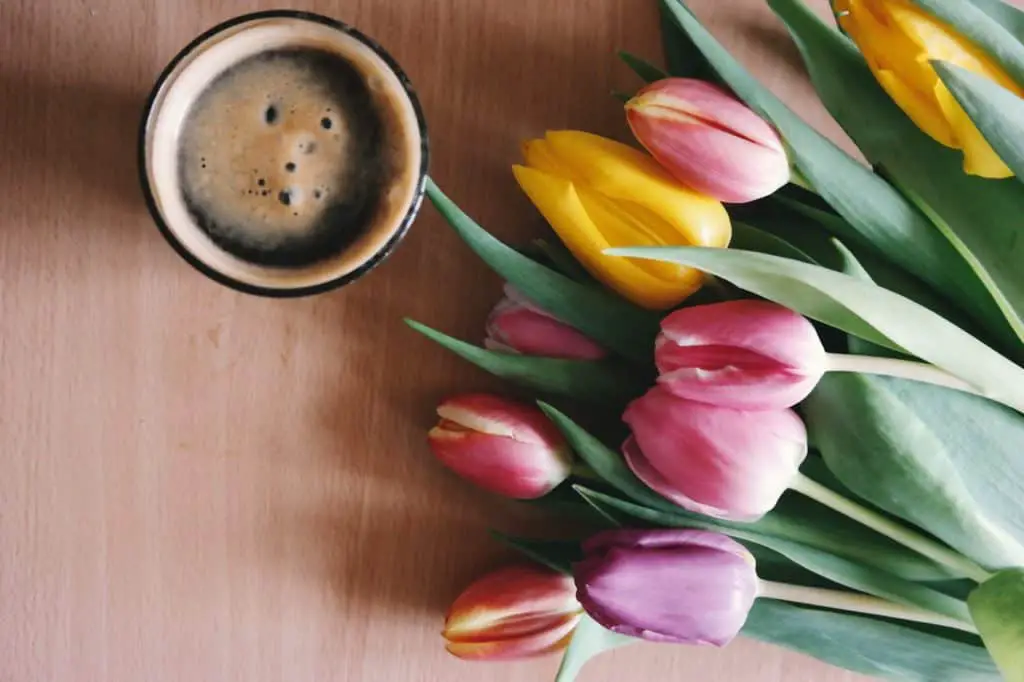Brewing great coffee is a science and an art combined. If you’ve had some truly fantastic pour over coffee at a local coffee joint and are wondering how to replicate it at home, there’s one step you need to take: take advantage of the coffee bloom!
Coffee Bloom science: how does it work?
In short, the coffee bloom is when carbon dioxide gas that was stored in the coffee rapidly escapes. The carbon dioxide is a natural by-product in the roasting process. Depending on the kind of roast you have, the levels of carbon dioxide will vary – but it’s there.
Carbon dioxide is slowly released from coffee beans after they’re roasted. This is through a process called degassing.
Once you grind the coffee beans, the gas is released much, much quicker thanks to the extra surface area and exposure to air. When you pour hot water onto the grounds, the remaining carbon dioxide is expelled out very quickly in a process known as turbulence.
The big issue caused by turbulence is that the rapidly escaping carbon dioxide essentially blocks water from actually reaching the coffee grounds and drawing out the flavor compounds.
You’ll also notice that as you pour hot water, the coffee bubbles up and a lot of the coffee grounds rise up with the expanding, releasing gas.
Effectively, this means that part of your brewing time is lost in the carbon dioxide escaping. So the time that water could have been interacting with the coffee grounds is instead spent by carbon dioxide preventing the water from fully reaching all the coffee grounds to begin with!
That’s why we bloom
To get around this issue, we bloom coffee before starting the full brew.
This is why we recommend you always buy freshly roasted coffee and grind just before you brew. As soon as the coffee has been roasted, the degassing process starts.
If you can buy freshly roasted beans and use them up within 10 days, there’s nothing like it.
This is also why we prefer you store coffee beans in airtight storage containers, or storage canisters specially designed for coffee. These come in two types: one with an airtight seal that effectively creates a vacuum, so the extra pressure causes the gas to release slower, or one with a special one-way valve that slowly releases the carbon dioxide from inside the container.
Sealed packages from the roaster often have small valves that let the carbon dioxide out. In case you’re wondering where you can get freshly roasted coffee, check out our list of the best coffee beans.
Carbon dioxide is not the only gas present – there are many other compounds in freshly ground coffee and these also lose their potency and strength as time goes on. Remember to always use freshly roasted coffee!
Why doesn’t my coffee bloom?
Here’s a neat trick you can use when making coffee. Use the bloom to gauge how fresh it really is. Remember, the coffee bloom occurs thanks to the rapid release of gases from the coffee grounds.
A stronger bloom means there’s a lot of gas in the coffee and it’s really fresh.
On the other hand, if you’re wondering why your coffee does not bloom, it usually indicates that your coffee has gone stale or it has been roasted too much.
Again, the solution is to use freshly roasted coffee and only grind right before you brew(check out some grinders here). I know, it adds a few minutes to your preparation time but it truly makes a huge difference in the flavor of the final product.
What affects the bloom?
Essentially, since the bloom is directly correlated with how much gas is left in the coffee beans, factors that affect the rate of gas release also affect the bloom.
Temperature
Coffee stored in a hotter area will lose carbon dioxide faster than if it was stored in a cool area. As far as possible, store your coffee away from light and heat. Light directly shining on an object slowly heats it up, so stick to a cool, dark area for best results.
Humidity
Drier environments will promote more gaseous release, but an environment too damp and humid will promote fungus and mold growth, so humidity is a bit of a catch-22. A balance between humidity and dryness will be the perfect place to store coffee. Not too damp but not too dry, either.
Roast
Darker roasts tend to lose gas a lot more slowly(and a lot less gas overall) than lighter roasts.
Origin
Some coffee beans have a higher tendency for degassing than other beans. The best way to see is just experiment and figure it out. You can also see how other people’s experiences have been.
Is blooming coffee necessary?
Generally, it’s a good idea to bloom coffee. Letting that extra bit of carbon dioxide escape will help the coffee grounds interact better with the water. It only takes 15-20 seconds to bloom coffee and that extra step is well worth the result.
How to bloom your coffee
With the science of the coffee bloom out of the way, let’s talk about how you can actually bloom your coffee using your favorite method.
Please note that you can’t really bloom coffee in an espresso machine, but you don’t need to, either, since the pressure of the water and steam will do the work in extracting all the flavors.
Blooming pour over/drip
Pour over is the most critical kind of coffee brew that you need to bloom, since you’re relying only on gravity to do the work for you.
Pour a tiny bit of hot water(no more than 50 ml or so if you’re brewing a single cup) over the coffee grounds just so that they soak through, but water doesn’t quite start to filter down into the cup.
Hitting the grounds with hot water will release the CO2, and in about 20 seconds or so you can pour the remaining water into the filter.
Blooming french press
Once your grounds are inside the french press, pour a small bit of hot water – only enough to evenly wet the coffee grounds, and no more(give it a stir to encourage all the grounds to get wet), and give it 20 seconds to bubble over.
After that, pour the rest of the water in.
In theory, you can get away with not blooming a french press brew since you’re steeping the coffee anyway and the water will most certainly interact with all the grounds within the 4 minutes of steeping.
Blooming Aeropress
To bloom an Aeropress, you need to be a bit more careful since even the slightest extra amount of water will cause the coffee to start dripping through the filter. This won’t be a problem if you’re using the inverted method, of course.
Once you grounds are in the Aeropress, pour a very small amount of hot water over the grounds to soak them evenly.
Wait 20-30 seconds and pour the remaining water in, stir, and brew normally.
Blooming cold brew
Cold brew is a bit more dicey to bloom since you’re going to be adding cold water after the initial bloom but since the process of brewing is so drawn out it should not affect the coffee too much.
You’ll need to use a bit more hot water, though, since there is a lot more coffee in cold brewing than there is in a hot brew.
Very carefully wet the grounds with hot water and wait 20 to 30 seconds for the bubbles to form and release, then pour cold water as usual and let it brew for 12-24 hours.
Frequently asked questions
What is the best temperature for coffee?
The ideal temperature to brew coffee is between 195-205 degrees F, or around 95 degrees C. This is the same temperature to use for blooming.
Is CO2 bad for coffee?
CO2 is a byproduct of roasting coffee beans. Too much CO2 in brewed coffee can result in a sour cup, as carbon dioxide makes water acidic.
Is it safe to use old coffee beans?
It is safe to use old coffee beans, but they won’t make as good of a coffee as freshly roasted beans.



